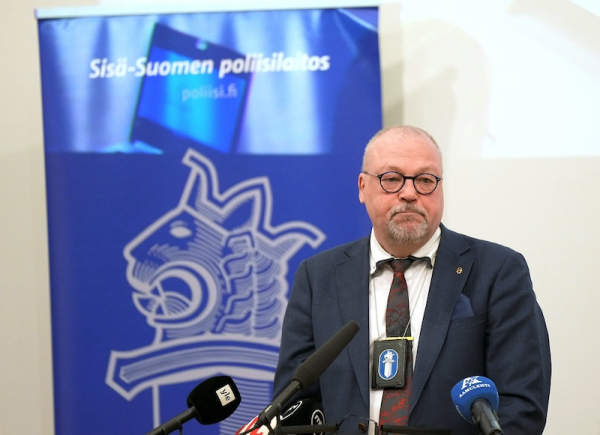
ari Kinnunen, Detective Chief Superintendent Central Finland Police Department, attends press conference about stabbing in the Vähäjärvi School in Pirkkala, pictured at the Central Finland Police Department in Tampere, Finland on May 20, 2025. Photo: Mika Kylmäniemi / Lehtikuva
- Previous Article Helsinki sees sharp rise in assaults by children under 15
- Next Article Alcohol use drops again in Finland despite easier access
Police in Finland are investigating whether misogyny played a role in a school stabbing that left three teenage girls injured in Pirkkala on Tuesday. The 16-year-old male suspect remains in custody and is being held on suspicion of three counts of attempted murder.
The incident took place during a break at Vähäjärvi School, where the suspect, also a student, allegedly targeted a group of girls, stabbing them in the neck, hand and waist with a knife. All three victims were treated and have since been discharged from hospital.
Investigators have confirmed that a manifesto, circulated online and shared with Finnish media shortly before the attack, is highly likely to have been written by the suspect. According to police, the document contained detailed descriptions of the planned attack and stated the intention to stab female pupils.
Detective Chief Inspector Jari Kinnunen, who is overseeing the case, said police believe the girls were deliberately chosen. The suspect had also filmed the act, though authorities have not disclosed whether the video has been published.
Researcher Tomi Kiilakoski from the Finnish Youth Research Network, who has studied previous school attacks, said the selection of girls as victims indicates elements of misogyny.
“We cannot yet confirm involvement in misogynistic online subcultures,” Kiilakoski said. “But the fact that girls were selected makes that element clear.”
Emilia Lounela, a University of Helsinki researcher who studies incel communities, said the case fits a wider cultural pattern, even if the suspect is not confirmed to have been part of any extremist group.
“The logic of viewing women as inferior is central to many misogynistic ideologies,” Lounela said. “This worldview is increasingly visible in online spaces and political discourse. It contributes to normalising violence.”
The suspect’s behaviour before the attack suggests he sought visibility and attention. The manifesto, which has been described as resembling a CV more than a political statement, lacked emotional content and detailed grievances.
“This points toward fame-seeking as one possible motive,” Kiilakoski said. “It’s a common feature in school attacks.”
He added that most perpetrators in school attacks have been male, and that such acts are often associated with a broader tradition of masculine violence.
“We don’t yet know whether this suspect studied past attacks, but he followed a kind of cultural script,” Kiilakoski said.
The suspect’s lawyer, Kaarle Gummerus, confirmed that the boy had cooperated during police interviews. He declined to comment on the suspect’s views about women or the extent of planning involved.
“The charges are extremely serious, and the accused is especially young,” Gummerus told Yle. “The case is exceptional in its nature, taking place in a public school and involving multiple victims.”
Gummerus said the suspect has been interviewed twice and has spoken with police. A court will consider his continued detention in a hearing in Pirkanmaa District Court.
He added that a decision on whether to oppose pretrial detention will be made after reviewing the prosecutor’s request.
The suspect is believed not to have known the victims personally. Police have not commented publicly on whether the boy was under the influence of any substances at the time.
According to both police and the defence, the attack appears to have been planned over a significant period, but the timeline is still under investigation.
The case has prompted a broader national conversation in Finland about youth violence, the spread of misogynistic content online, and the need for early intervention.
School authorities have not commented publicly on the attack. Vähäjärvi School, which serves around 1,200 pupils from preschool to ninth grade, remains open under heightened security.
The incident has added to concerns among researchers and policymakers about the increasing visibility of hate-driven ideologies among adolescents and the role of digital platforms in shaping young minds.
Both Lounela and Kiilakoski say that cultural, educational and peer influences play a critical role in understanding why some youths resort to violence. They note that while definitive answers are often elusive, patterns are becoming harder to ignore.
HT
- Previous Article Helsinki sees sharp rise in assaults by children under 15
- Next Article Alcohol use drops again in Finland despite easier access
Source: www.helsinkitimes.fi
